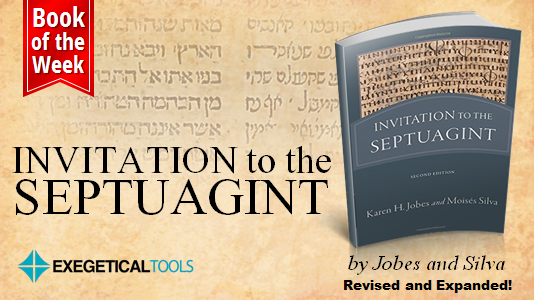You’re invited to Septuagint studies…again! Karen Jobes and Moisés Silva have revised and expanded their fantastic introduction to the blooming field of Septuagint studies. And we mean it: refuse at your peril. If you haven’t yet read a good introduction to this field, there are several reasons why you should, and many reasons why Jobes and Silva is the best place to start.
Why Septuagint Studies?
In decades and centuries past, the LXX has been used often as evidence of early Jewish interpretations of the MT. But recent studies have found far more use for the LXX. This includes its use for textual criticism, for ancient Jewish sociological and historical investigation, for the study of Greek, for better understanding the NT authors’ use of the OT, and for the study of second-temple Jewish theology.
In short, if you’re not at least acquainted with the basic issues of the formation of the Septuagint, its text, and how to approach it for use in biblical studies, you need to ASAP.
Jobes and Silva as Accessible and Reliable Guides
Jobes and Silva’s first edition of Invitation to the Septuagint has been popular and frequently used. This second edition gives it new life by expanding every chapter with updated sources and discussions of developments over the last 15 years.
The book falls into four parts. The first explains the history of the LXX including its relation to other Greek versions, its transmission, modern editions, and issues related to its translation. Part two discusses its use in biblical studies, including the quality of its Greek (especially Semitic influence), attempts to establish its text, its use for OT textual criticism, and how it helps with Qumran and NT studies. Part three is somewhat unique to this book. It dedicates a chapter to the founders of LXX studies and influential modern scholars, current linguistic issues, attempts to reconstruct the text’s history, and what the LXX tells us about Jewish theology in the Hellenistic era.
Throughout the book are useful case studies. To demonstrate the LXX’s value for OT textual criticism, they discuss instances where the LXX may contain an earlier reading, such as “David” instead of “circle” in Isa 29:3 (possible), “Moses finished speaking” rather than “and Moses went and spoke” in Deut 31:1 (supported by the Hebrew of 1QDeut^a 13 II, 4), and an entire sentence in 2 Sam 14:30 missing from the MT, but found in 4QSam, thus virtually confirming the LXX as the better reading.
To demonstrate the problems of interpreting the LXX, Jobes and Silva provide a chapter that interprets the LXX of Gen 4:1-8 almost word for word, Isa 52:13-53:12 selectively, and Esther 5:1-2 with Addition D to show the difficulties of sections with competing Greek translations and with material not paralleled in the MT. The reader therefore sees theory in action.
In addition to the many other case studies are a plethora of tables, diagrams, and graphics. Diagrams help the reader see how the LXX relates to the MT and other Greek versions (pp. 35, 39, 49); tables compare the book order of the MT, LXX, and Protestant English Bibles, they they MT and LXX texts side by side for comparison, and more; the best graphics are those that show a page of a critical LXX edition (e.g., Göttingen or Larger Cambridge) with an explanation of the apparatus on the adjacent page.
There are several other helpful sections. I enjoyed the biographical sections on Septuagint scholars as well as the discussion of the use of the LXX in NT use of the OT studies. Throughout, Jobes and Silva explain methodological considerations but also often give specific steps to walk through when studying an issue. For all these reasons, this book is one of the best places to start for most issues related to LXX studies.
Jobes and Silva in Comparison
There are several other introductions to the LXX, such as McLay’s Use of the Septuagint in New Testament Research, Law’s When God Spoke Greek, and Dines’s The Septuagint. Each volume has its own strengths and focuses on different areas within LXX studies. However, for the beginning student or the pastor who wants to learn how to use the LXX sensitively when studying the text while preparing for sermons, I suggest Jobes and Silva’s new second edition is the best place to start.
You’re invited to preview or buy it here.


